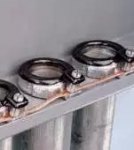Jim1959
Senior Member
- Location
- Longmont, CO
I have a customer inspector who claims the smallest size bonding jumper in a classified area is #8 per the following logic. I don't agree, I believe Table 250.122 can be used to size the bonding conductor, what is correct?
As per ourdiscussion on the bonding wire size of hubs and doors.
2017 NEC 250.100 Bonding in Hazardous(Classified) Locations.
Regardless of the voltage of the electricalsystem, the electrical continuity of non–current-carrying metal parts ofequipment, raceways, and other enclosures in any hazardous (classified)location, as defined in 500.5, 505.5, and 506.5, shall be ensured by any of thebonding methods specified in 250.92(B)(2) through (B)(4). One or more ofthese bonding methods shall be used whether or not equipment groundingconductors of the wire type are installed.
2017 NEC 250.92 Services. Because the reference is under "Services", Table250.102(C)(1) is used to determine the smallest bonding jumper that can be usedto be #8.
As per ourdiscussion on the bonding wire size of hubs and doors.
2017 NEC 250.100 Bonding in Hazardous(Classified) Locations.
Regardless of the voltage of the electricalsystem, the electrical continuity of non–current-carrying metal parts ofequipment, raceways, and other enclosures in any hazardous (classified)location, as defined in 500.5, 505.5, and 506.5, shall be ensured by any of thebonding methods specified in 250.92(B)(2) through (B)(4). One or more ofthese bonding methods shall be used whether or not equipment groundingconductors of the wire type are installed.
2017 NEC 250.92 Services. Because the reference is under "Services", Table250.102(C)(1) is used to determine the smallest bonding jumper that can be usedto be #8.

